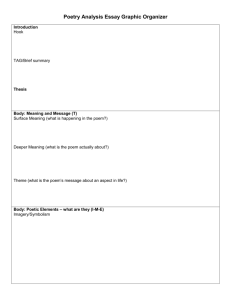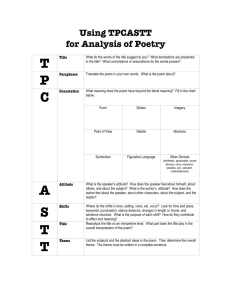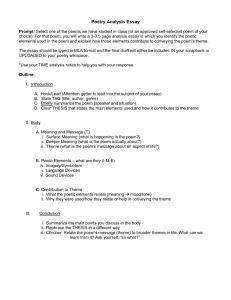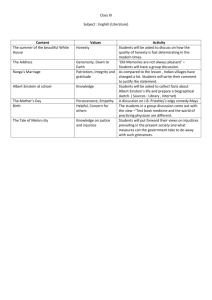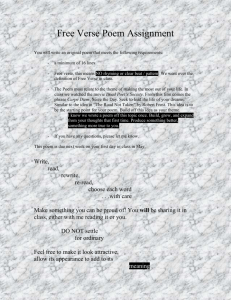Ms. Menards Honors English Packet for the Poetry Essay
advertisement
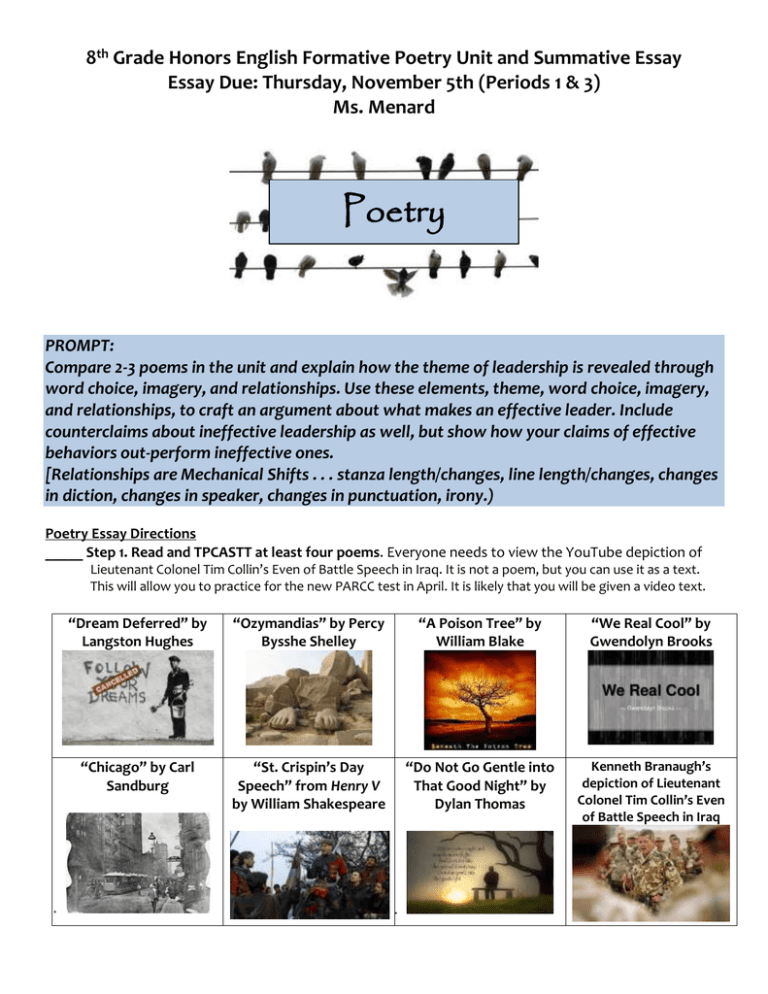
8th Grade Honors English Formative Poetry Unit and Summative Essay Essay Due: Thursday, November 5th (Periods 1 & 3) Ms. Menard Poetry PROMPT: Compare 2-3 poems in the unit and explain how the theme of leadership is revealed through word choice, imagery, and relationships. Use these elements, theme, word choice, imagery, and relationships, to craft an argument about what makes an effective leader. Include counterclaims about ineffective leadership as well, but show how your claims of effective behaviors out-perform ineffective ones. [Relationships are Mechanical Shifts . . . stanza length/changes, line length/changes, changes in diction, changes in speaker, changes in punctuation, irony.) Poetry Essay Directions _____ Step 1. Read and TPCASTT at least four poems. Everyone needs to view the YouTube depiction of Lieutenant Colonel Tim Collin’s Even of Battle Speech in Iraq. It is not a poem, but you can use it as a text. This will allow you to practice for the new PARCC test in April. It is likely that you will be given a video text. 1. “Dream Deferred” by Langston Hughes “Ozymandias” by Percy Bysshe Shelley “A Poison Tree” by William Blake “We Real Cool” by Gwendolyn Brooks “Chicago” by Carl Sandburg “St. Crispin’s Day Speech” from Henry V by William Shakespeare “Do Not Go Gentle into That Good Night” by Dylan Thomas Kenneth Branaugh’s depiction of Lieutenant Colonel Tim Collin’s Even of Battle Speech in Iraq 1. _____ Step 2. Then design your ARGUMENT about an effective leader. Use quotes and very specific examples from the texts. _____ Step 3. Set up your paper in MLA format. _____ Open a MS Word document and set up double spacing FIRST. (Reminder: In Word, click on the little square/arrow button on the bottom right corner of the PARAGRAPH box. Double check three settings: Before = 0, After = 0, Line Spacing = Double.) _____ Type the HEADING at the top of page one. Do not, do not, do not put the HEADING in the HEADER. Never use the header. Kallie Kane Ms. Menard English 8 – Period 7 26 October 2014 Creative Title Centered and in Size 12 Bold _____ Type all poem titles in “quotes” with capital letters for words longer than three letters or for the first word in the title. Example: “A Poison Tree” by William Blake… _____ When you quote a poem in the essay it is called an in-text citation. (Why? Because you are citing, or quoting, the poem in the text.) The in-text citation for a poem looks like this: Essay, essay, your words go here, essay, essay, essay. “Quote” (Blake 3-4). What does the 3-4 mean? Line numbers. Another option: Essay, essay, your words go here, essay, essay, essay. “Quote…quote” (Blake 3-4, 7). This citation shows that the writer quoted three different lines: lines 3, 4, and 7. _____ Use the / symbol to show line breaks in a poem. Let me explain. Poetry has short lines. Prose has long lines that overflow into each other. How do you show a line break in a poem when you type? Like this: Roses are red/violets are blue/sugar is sweet/woo-hoo-hoo. _____ Create a double spaced Works Cited page in MLA format. (Check OWL at Purdue for help.) Always center Works Cited at the top of the page with 1 inch margins. Always give the Works Cited page its own page. Do not put it at the bottom of the essay. Always write the entries in alphabetical order. Always tab the second “overflow” line so the first line stands out. (We’ll practice in class.) _____ Step 4. Write all five of the “green” sentences because they are the most important. _____ Thesis Statement in the Introduction (mention “Title,” author, theme, and prompt) _____ Topic sentence #1 about three images that reveal the theme and offer leadership advice _____ Topic sentence #2 about three word choice examples that reveal the theme and leadership _____ Topic sentence #3 about the relationship development that reveals the theme and leadership _____ Thesis Statement in the Conclusion (restated, very similarly, yet not quite the same) _____ Step 5. Write the Introduction Paragraph. _____ Connect to the world: Begin with a hook about the topic of leadership, not about the poems. _____ In one sentence only, summarize the poems in a blue background knowledge description. _____ In one sentence only, give a tiny definition of leadership and give context of the essay. _____ Add the thesis statement you already drafted in Step 6. The thesis must state the prompt, “Title,” author, and key elements of the prompt, including imagery, word choice, and relationships as pieces that reveal an effective leader. _____ Step 6. Write the first Body Paragraph about imagery or images that reveal positive or negative leadership traits, and state a claim about what the reader should learn from these examples. _____ The first sentence must be the topic sentence, and you can paste it from Step 6. It must connect to the prompt, restate the claim, and use the domain words theme, imagery, leadership, and effective (or a synonym of effective). _____ You can skip blue background information because you already provided it in the Intro. _____ The first yellow/red/red section needs to state the image in the yellow, along with very specific details and the theme. Include a “red” quote from the poem that describes an image or the impact of an image. In the “red” analysis or explanation, be very specific. What lesson is learned? Why does the image of --- matter to the message? Is the image one of the important pieces that lead to the overall theme? What can people learn from the poem’s message? What happens in the message isn’t learned? Any of these ideas can be discussed. Now explain how your analysis (the answer to one of the questions above) reveals a claim about leadership. _____ The second yellow/red/red section is like the one listed above, but a new image is described and used to make a claim about leadership. _____ Repeat the process for the third yellow/red/red section. _____ Somewhere in this paragraph, include the following things: _____ simile/metaphor and personification _____ pathos (create an emotion for the reader) _____ a deeper explanation about how a specific detail communicates to the reader _____ 10 domain and 8 regular vocabulary words _____ one sentence in this pattern: Sentence, BOYFANS, sentence. (BOYFANS = but, or, yet, for, and, nor, so) _____ Step 7. Write the second Body Paragraph about three specific words or phrases that impact meaning in the poems, and use these examples to deepen the claims in your argument about the behaviors and beliefs of an effective leader. _____ The first sentence must be the topic sentence. Add this sentence from the list of green sentences you brainstormed in Step 6. This is the sentence about how the word choice of a poem offers advice and conclusions, and this supports a claim about leadership. _____ You can skip blue background information because you already provided it in the Intro. _____ The first yellow/red/red section needs to state the word or phrase in the yellow, along with very specific details and the theme. Include a “red” quote from the poem that describes how the word or phrase CREATES MEANING ABOUT THE THEME, or state the impact of the theme on the message or reader. In the “red” analysis or explanation, be very specific. What lesson is learned? Why does the word or phrase matter to the message? Does this word lead to the theme like a puzzle piece clue? Is this word used differently in the poem, or does the word always have this meaning whenever it is used? Does the word or phrase have a double meaning, or does the meaning change for a significant reason? Any of these ideas can be discussed. After you answer one or two of the questions above, then connect the lesson to leadership. (This entire YRR section is not allowed to be longer than 4 sentences. Three is better.) _____ The second yellow/red/red section is like the one listed above, but a new word is described. _____ Repeat the process for the third yellow/red/red section. _____ Somewhere in this paragraph, include the following things: _____ anaphora or alliteration _____ ethos (expertise or ethics) _____ a deeper explanation about how a specific detail communicates to the reader _____ 10 domain and 8 regular vocabulary words _____ one sentence in this pattern: Either…, or…. _____ one sentence in this pattern: One would expect the word --- to mean “blah,” but in this case the message… _____ Step 8. Write the third Body Paragraph about relationships (which means the mechanical shifts in a poem. Those are big words that mean Where does the change occur? Connect this to your claim about effective leadership. _____ The first sentence must be the topic sentence. This is the sentence about how the mechanical shifts, or the relationships between ideas, reveal the theme through a CHANGE or SHIFT IN TONE OR VOICE. Claim how this lesson offers advice to leaders. _____ This paragraph is more complicated. Does your reader need background information to understand your point? If so, define a word or idea here in the “blue” background knowledge. (Optional) _____ In the first yellow/red/red section, “define” what “normal” looks like in the beginning of your poem. For example, maybe it’s normal for a man to be angry with his friend. Maybe normal is for a warrior to want to quit because he’s embarrassed that he made a mistake. Maybe normal in a poem shows that it’s easy to get so busy that a person misses the small joys in life. That is what this YRR section is for. Describe normal, include a quote, and explain why or how this is the normal routine. Then prove how this “normal” is leadership advice. _____ The second YRR is different here. Now find ONE way that “normal” is no longer “normal.” How did something change it or upgrade the expectation? Use this YRR to STATE THE EXACT THING THAT CAUSED THE CHANGE, or to STATE THE CHANGE. Maybe the tone of voice switched from revengeful to forgiving. Maybe the speaker reflected and realized that he messed up in the past, but he has a second chance in the future. Maybe the too-busy person learned a lesson from a skunk and will think differently now. WHAT is the change, and WHY did it happen? What should a leader learn from this change or this new normal? _____ The third YRR is the most important section in the whole essay. It’s like the punchline of a joke, so all the pieces pull together into this one part. In this YRR combo, explain how IRONY is used above and below the shift. How is the ending ironic (unexpected) from the opening of the poem? This YRR is ALL ABOUT THE CHANGE and HOW IT REVEALS THE THEME. Again, connect this to leadership in a claim or counterclaim about what effective leadership looks like or doesn’t look like. Explain this with a quote and a very, very, very, very specific and detailed final red. _____ Somewhere in this paragraph, include the following things: _____ allusion _____ irony _____logos (cause and effect; this caused that; step one, step two; or numbers, stats, etc.) _____ a deeper explanation about how a specific detail communicates to the reader _____ 10 domain and 8 regular vocabulary words _____ one sentence in this pattern: Even though -----, in this case, --------. (counterclaim) Poetry Essay Essential Ingredients – Planning the Essay After completing TPCASTT in detail, I know the theme of this poem is: THEME IS REVEALED THROUGH WORD CHOICE The word The word The word reveals the theme because reveals the theme because reveals the theme because The exact line is: The exact line is: The exact line is: THEME IS REVEALED THROUGH IMAGES One image presented in the poem is: One image presented in the poem is: One image presented in the poem is: Evidence from the poem describes this image as: Evidence from the poem describes this image as: Evidence from the poem describes this image as: * * * * * * It reveals the theme because: It reveals the theme because: It reveals the theme because: THEME IS REVEALED ABOUT THE RELATIONSHIPS in the poem. Relationships are MECHANICAL SHIFTS, or changes in structure, tone, speaker, or message (irony). What is the normal situation early in the poem? How does “normal” change in one significant way later in the poem? How is irony revealed between the previous normal and the new normal? Which line provides the best evidence? Which line provides the best evidence? Which line provides the best evidence? How does this connect to theme? How does this connect to theme? What is the theme, and why is it important? We Real Cool by Gwendolyn Brooks We real cool. We Left school. We Lurk late. We Strike straight. We Sing sin. We Thin gin. We Jazz June. We Die soon. Do not go gentle into that good night Dylan Thomas, 1914 - 1953 Do not go gentle into that good night, Old age should burn and rave at close of day; Rage, rage against the dying of the light. Though wise men at their end know dark is right, Because their words had forked no lightning they Do not go gentle into that good night. Good men, the last wave by, crying how bright Their frail deeds might have danced in a green bay, Rage, rage against the dying of the light. Wild men who caught and sang the sun in flight, And learn, too late, they grieved it on its way, Do not go gentle into that good night. Grave men, near death, who see with blinding sight Blind eyes could blaze like meteors and be gay, Rage, rage against the dying of the light. And you, my father, there on the sad height, Curse, bless, me now with your fierce tears, I pray. Do not go gentle into that good night. Rage, rage against the dying of the light. A Dream Deferred by Langston Hughes What happens to a dream deferred? Does it dry up like a raisin in the sun? Or fester like a sore-And then run? Does it stink like rotten meat? Or crust and sugar over-like a syrupy sweet? Maybe it just sags like a heavy load. Or does it explode? A Poison Tree By William Blake I was angry with my friend; I told my wrath, my wrath did end. I was angry with my foe: I told it not, my wrath did grow. And I waterd it in fears, Night & morning with my tears: And I sunned it with smiles, And with soft deceitful wiles. And it grew both day and night. Till it bore an apple bright. And my foe beheld it shine, And he knew that it was mine. And into my garden stole, When the night had veild the pole; In the morning glad I see; My foe outstretched beneath the tree. St. Crispin’s Day Speech from Henry V by William Shakespeare Enter the KING WESTMORELAND O that we now had here But one ten thousand of those men in England That do no work to-day! KING HENRY V What's he that wishes so? My cousin Westmoreland? No, my fair cousin: If we are mark'd to die, we are enow To do our country loss; and if to live, The fewer men, the greater share of honour. God's will! I pray thee, wish not one man more. By Jove, I am not covetous for gold, Nor care I who doth feed upon my cost; It yearns me not if men my garments wear; Such outward things dwell not in my desires: But if it be a sin to covet honour, I am the most offending soul alive. No, faith, my coz, wish not a man from England: God's peace! I would not lose so great an honour As one man more, methinks, would share from me For the best hope I have. O, do not wish one more! Rather proclaim it, Westmoreland, through my host, That he which hath no stomach to this fight, Let him depart; his passport shall be made And crowns for convoy put into his purse: We would not die in that man's company That fears his fellowship to die with us. This day is called the feast of Crispian: He that outlives this day, and comes safe home, Will stand a tip-toe when the day is named, And rouse him at the name of Crispian. He that shall live this day, and see old age, Will yearly on the vigil feast his neighbours, And say 'To-morrow is Saint Crispian:' Then will he strip his sleeve and show his scars. And say 'These wounds I had on Crispin's day.' Old men forget: yet all shall be forgot, But he'll remember with advantages What feats he did that day: then shall our names. Familiar in his mouth as household words Harry the king, Bedford and Exeter, Warwick and Talbot, Salisbury and Gloucester, Be in their flowing cups freshly remember'd. This story shall the good man teach his son; And Crispin Crispian shall ne'er go by, From this day to the ending of the world, But we in it shall be remember'd; We few, we happy few, we band of brothers; For he to-day that sheds his blood with me Shall be my brother; be he ne'er so vile, This day shall gentle his condition: And gentlemen in England now a-bed Shall think themselves accursed they were not here, And hold their manhoods cheap whiles any speaks That fought with us upon Saint Crispin's day. Ozymandias Percy Bysshe Shelley I met a traveller from an antique land Who said: "Two vast and trunkless legs of stone Stand in the desert. Near them on the sand, Half sunk, a shattered visage lies, whose frown And wrinkled lip and sneer of cold command Tell that its sculptor well those passions read Which yet survive, stamped on these lifeless things, The hand that mocked them and the heart that fed. And on the pedestal these words appear: `My name is Ozymandias, King of Kings: Look on my works, ye mighty, and despair!' Nothing beside remains. Round the decay Of that colossal wreck, boundless and bare, The lone and level sands stretch far away". CHICAGO by Carl Sandburg HOG Butcher for the World, Tool Maker, Stacker of Wheat, Player with Railroads and the Nation's Freight Handler; Stormy, husky, brawling, City of the Big Shoulders: They tell me you are wicked and I believe them, for I have seen your painted women under the gas lamps luring the farm boys. And they tell me you are crooked and I answer: Yes, it is true I have seen the gunman kill and go free to kill again. And they tell me you are brutal and my reply is: On the faces of women and children I have seen the marks of wanton hunger. And having answered so I turn once more to those who sneer at this my city, and I give them back the sneer and say to them: Come and show me another city with lifted head singing so proud to be alive and coarse and strong and cunning. Flinging magnetic curses amid the toil of piling job on job, here is a tall bold slugger set vivid against the little soft cities; Fierce as a dog with tongue lapping for action, cunning as a savage pitted against the wilderness, Bareheaded, Shoveling, Wrecking, Planning, Building, breaking, rebuilding, Under the smoke, dust all over his mouth, laughing with white teeth, Under the terrible burden of destiny laughing as a young man laughs, Laughing even as an ignorant fighter laughs who has never lost a battle, Bragging and laughing that under his wrist is the pulse. and under his ribs the heart of the people, Laughing! Laughing the stormy, husky, brawling laughter of Youth, half-naked, sweating, proud to be Hog Butcher, Tool Maker, Stacker of Wheat, Player with Railroads and Freight Handler to the Nation. Iambic Pentameter Chart for an Elizabethan Sonnet about Leadership Ŭ Ś Ŭ Ś Ŭ Ś Ŭ Ś Ŭ Ś Rhyme A B A B C D C D E F E F G G . Advanced Produce clear and coherent writing in which the development, organization, and style are appropriate to task, purpose, and audience. The sonnet is written in iambic pentameter with ten beats per line in an ababcdcdefefgg pattern. A problem is presented in the first four lines, followed by a solution. The final two lines contain a “punchline” or a conclusion to the issue. Proficient Produce clear and coherent writing in which the development, organization, and style are appropriate to task, purpose, and audience. The sonnet is written in iambic pentameter with ten beats per line in an ababcdcdefefgg pattern. The final two lines summarize the topic while the other 12 lines address one specific topic in a logical way. Partially Proficient Although the development, organization, and style are attempted, they might be confusing at times, or the rhyme scheme may be incorrect. It is possible that the number of syllables in a line is more or less than ten, or that the poem has many main ideas instead of one with development. In Progress There are times when the sonnet follows the correct rhyme scheme or pattern, but sometimes or all of the time it does not follow the abba pattern with ten beats per line. The topic may not be focused on one idea, it may lack development or be confusing, or the pattern may not be followed at all. The final product does not look or sound like a sonnet.
